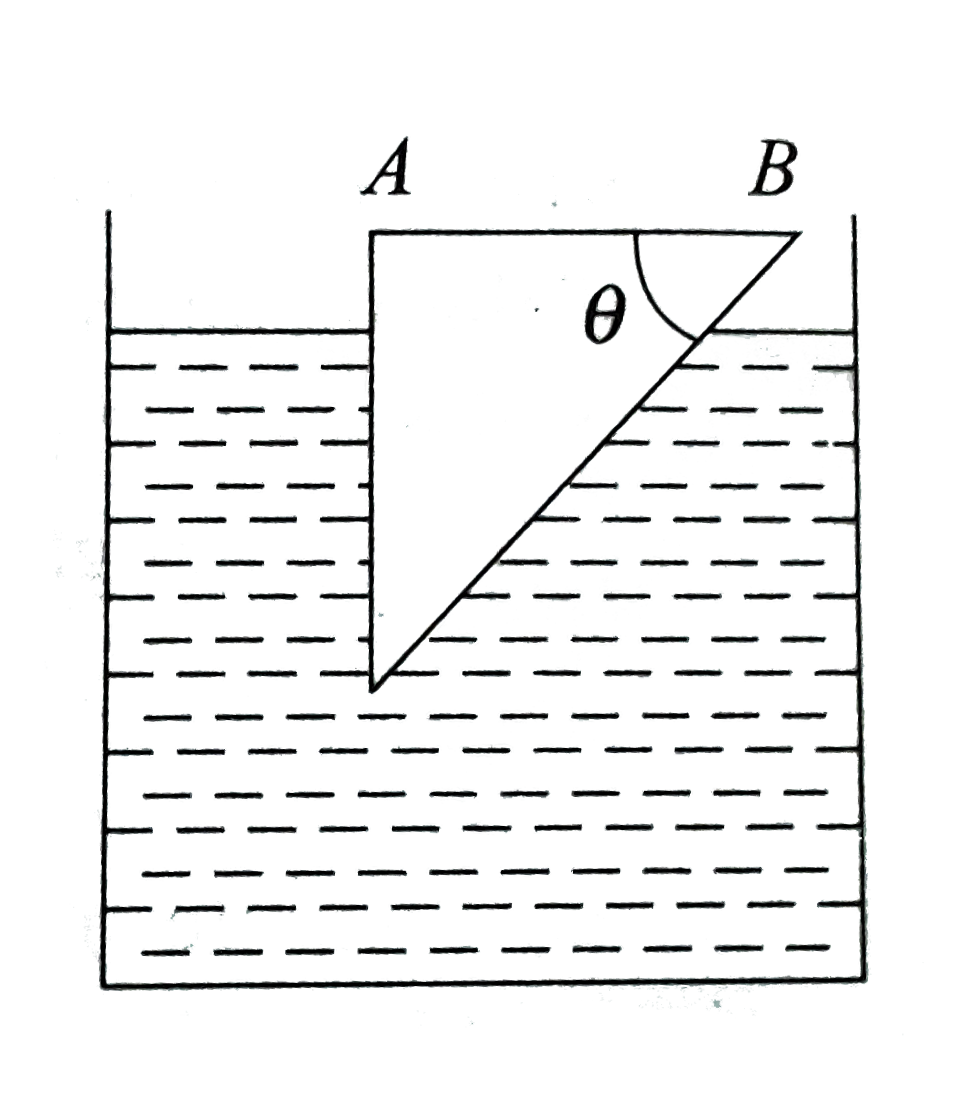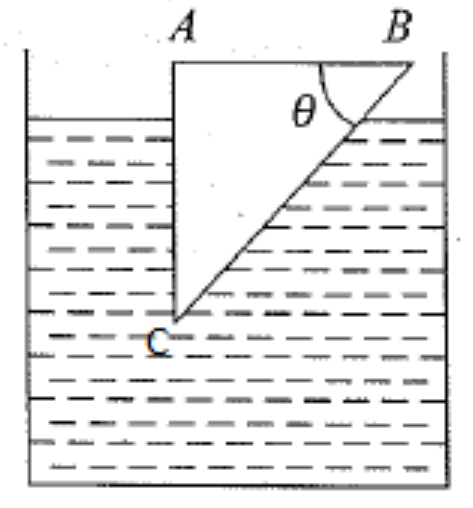A thin oil film of refractive index 1.2 floats on the surface of water (μ=43). When a light of wavelength λ=9.6×10−7m falls normally on the film from air, then it appears dark when seen normally. The minimum change in its thickness for which it will appear bright in normally reflected light by the same light is:
10−7m
2×10−7m
3×10−7m
5×10−7m
The correct Answer is:B
To solve the problem, we need to determine the minimum change in thickness of a thin oil film that causes it to change from appearing dark to appearing bright when viewed normally.
1. Understanding the Condition for Dark Appearance:
When light reflects off a thin film, it can interfere constructively or destructively. For the film to appear dark, the condition for destructive interference must be satisfied. The path difference for destructive interference is given by:
Δx=(2n−1)λ2
where n is an integer, and λ is the wavelength of the light.
2. Path Difference Calculation:
The path difference for light reflecting off the top and bottom surfaces of the oil film is given by:
Δx=2t⋅n1
where t is the thickness of the film and n1 is the refractive index of the oil film (1.2).
Since the light is reflecting off a medium of higher refractive index (water) from the oil, we have:
2t⋅n1=(2n−1)λ2
3. Condition for Bright Appearance:
For the film to appear bright, the condition for constructive interference must be satisfied:
Δx=nλ
Thus, for the new thickness t′:
2t′⋅n1=nλ
4. Finding the Change in Thickness:
We want to find the minimum change in thickness Δt=t′−t. Rearranging the equations for t and t′:
- From the dark condition:
t=(2n−1)λ4n1
- From the bright condition:
t′=nλ2n1
Now substituting these into the change in thickness:
Δt=t′−t=(nλ2n1)−((2n−1)λ4n1)
Simplifying:
Δt=2nλ−(2n−1)λ4n1=(2n−2n+1)λ4n1=λ4n1
5. Substituting Values:
Now, substituting λ=9.6×10−7m and n1=1.2:
Δt=9.6×10−74×1.2=9.6×10−74.8=2×10−7m
Final Answer:
The minimum change in thickness for which the film will appear bright in normally reflected light is:
Δt=2×10−7m
When light reflects off a thin film, it can interfere constructively or destructively. For the film to appear dark, the condition for destructive interference must be satisfied. The path difference for destructive interference is given by:
Δx=(2n−1)λ2
where n is an integer, and λ is the wavelength of the light.
The path difference for light reflecting off the top and bottom surfaces of the oil film is given by:
Δx=2t⋅n1
where t is the thickness of the film and n1 is the refractive index of the oil film (1.2).
2t⋅n1=(2n−1)λ2
For the film to appear bright, the condition for constructive interference must be satisfied:
Δx=nλ
Thus, for the new thickness t′:
2t′⋅n1=nλ
We want to find the minimum change in thickness Δt=t′−t. Rearranging the equations for t and t′:
- From the dark condition:
t=(2n−1)λ4n1
- From the bright condition:
t′=nλ2n1
Δt=t′−t=(nλ2n1)−((2n−1)λ4n1)
Simplifying:
Δt=2nλ−(2n−1)λ4n1=(2n−2n+1)λ4n1=λ4n1
Now, substituting λ=9.6×10−7m and n1=1.2:
Δt=9.6×10−74×1.2=9.6×10−74.8=2×10−7m
The minimum change in thickness for which the film will appear bright in normally reflected light is:
Δt=2×10−7m
Topper's Solved these Questions
- WAVE OPTICSBOOK - DC PANDEY ENGLISHCHAPTER - WAVE OPTICSEXERCISE - For JEE Advanced B. More than one option is correct
4 Videos
- WAVE OPTICSBOOK - DC PANDEY ENGLISHCHAPTER - WAVE OPTICSEXERCISE - For JEE Advanced C. Comprehension Type Questions. Passage (I)
2 Videos
- WAVE OPTICSBOOK - DC PANDEY ENGLISHCHAPTER - WAVE OPTICSEXERCISE - For JEE main (Only one option is Correct )
22 Videos
- SOLVED PAPERS 2018BOOK - DC PANDEY ENGLISHCHAPTER - SOLVED PAPERS 2018EXERCISE - JIPMER
22 Videos
Similar Questions
A thin oil film of refracting index 1.2 floats on the surface of water (μ=43). When a light of wavelength λ=9.6×10−7m falls normally on the film air, then it appears dark when seen normally. The minimum change in its thickness for which it will appear bright in normally reflected light by the same light is Z×10−7m. Then find Z.
View SolutionA light of wavelength 5890Å falls normally on a thin air film. The minimum thickness of the film such that the film appears dark in reflected light is
View Solution
Knowledge Check
A parallel beam of sodium light of wavelength 6000Å is incident on a thin glass plate of μ=1.5, such that the angle of refraction in the plate is 60∘. The smallest thickness of the plate which will make it appear dark by reflected light is
A3926 Ã…B4353 Ã…C1396 Ã…D1921 Ã…
Light of wavelength 5900×10−10m falls normally on a slit of width 11.8×10−7m. The resulting diffraction pattern is received on a screen. The angular position of the first minimum is.
View SolutionA glass of refractive index 1.5 is coated with a thin layer of thickness t and refractive index 1.8 . Light of wavelength λ travelling in air is incident normally on the layer. It is partly reflected at the upper and the lower surfaces of the layer. It is partly reflected at the upper and the lower surfaces of the layer ant the two reflected rays interface . If λ=648nm, obtain the least value of t(in10−8m) which the rays interface constructively.
View SolutionA glass prism of refractive index 1.5 is immersed in water (refractive index 4/3) . A light beam normally on the face AB is totally reflected to reach on the face BC if

View SolutionA parallel beam of light of wavelength 560 nm falls on a thin film of oil (refractive index = 1.4). What should be the minimum thickness of the film so that it strongly transmit the light ?
View SolutionA glass prism of refractive index 1.5 is immersed in water of refractive index 4/3. A light ray incident normally on face AB is totally reflected at face AC if

View SolutionAn oil film covers the surface of a small pond. The refractive index of the oil is greater than that of water. At one point on the film, the film has the smallest non-zero thickness for which there will be destructive interference in the reflected light when infrared radiation with wavelength 800 nm is incident normal to the film. When this film is viewed at normal incidence at this same point, for what visible wavelengths, if any, will there be constructive interference? (Visible light has wavelengths between 400nm and 700 nm )
View SolutionLight of wavelength 3000A is incident on a thin glass plate of refractive index 1.5 such that angle of refraction into plate is 60° .calculate the thickness of plate which will make it appear dark by reflection?
View Solution
